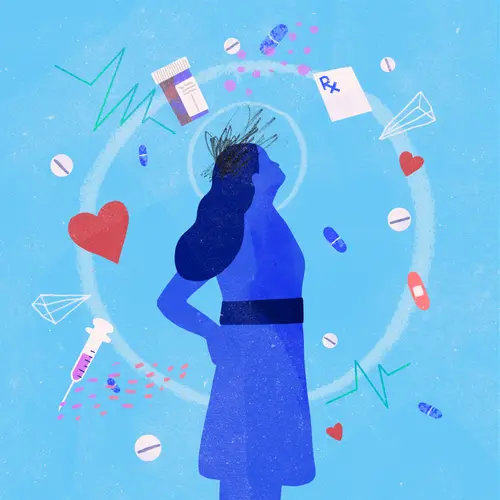Polycystic liver disease (PLD or PCLD) is a rare condition that causes cysts -- fluid-filled sacs -- to grow throughout the liver. A normal liver has a smooth, uniform appearance. A polycystic liver can look like a cluster of very large grapes. Cysts also can grow independently in different parts of the liver. The cysts, if they get too numerous or large, may cause discomfort and health complications. But most people with polycystic liver disease do not have symptoms and live a normal life.
Here are the facts about polycystic liver disease you need to better understand the condition.
What Causes Polycystic Liver Disease?
The majority of people with polycystic liver disease inherit the condition, but PLD can occur randomly with no genetic link. Women are affected by more severe disease compared to men.
PLD is most common in people who have polycystic kidney disease (PCKD), with its frequency increasing with age and advanced renal disease.
Most people don't discover they have PLD until they are adults when the cysts become large enough to detect. Cysts can vary in size from no bigger than a pinhead to almost 4 inches wide. Likewise, your liver can stay its normal size or become extremely enlarged. No matter the number or size of cysts, polycystic livers continue to function normally and, in most cases, the disease is not considered life-threatening.
Because it's most often inherited, if you or someone in your immediate family has PLD, other family members should be tested for it. Doctors can diagnose polycystic liver disease with imaging studies, such as ultrasound, CT scan, or MRI.
What Are the Symptoms of Polycystic Liver Disease?
Most of the time, people with polycystic liver disease have no symptoms. However, if the liver becomes very enlarged and bulky with cysts, symptoms may include:
- Bloating or swelling in the abdomen
- Abdominal pain
- Feeling full
- Shortness of breath
Only about one out of every 10 people with PLD has problems associated with it. In addition to severe abdominal pain, other complications may include:
How Is Polycystic Liver Disease Diagnosed?
Because symptoms do not always occur, many people learn they have PLD incidentally or after a diagnosis of kidney disease related to polycystic kidney disease.
An ultrasound is typically the first test used to look for the presence of liver cysts. The fact that you may have a few cysts does not mean you have polycystic liver disease because there are other more common causes of cysts in the liver. Many factors are involved in diagnosing PLD, including family history, age, and number of cysts.
You may be diagnosed with polycystic liver disease if:
- You have a family member with PLD, are under the age of 40, and have more than one cyst.
- You have a family member with PLD, are older than 40, and have more than three cysts.
- You have no family members with PLD, are over the age of 40, and have more than 20 cysts.
How Is Polycystic Liver Disease Treated?
Treatment is usually not needed unless you have symptoms. Mild pain associated with PLD can be treated with pain medication. However, if the cysts cause significant discomfort or other complications, there are a number of treatment options. Which option is best for you will depend on the extent of your pain, the location of the cysts, and other complications. Treatments may include:
- Cyst aspiration: If a cyst is blocking a bile duct or if it has become infected, your doctor may recommend draining it. During cyst aspiration, your doctor, guided by ultrasound or CT imaging, will use a needle or catheter to drain the fluid in the cyst or cysts. Unfortunately, cyst aspiration offers only temporary relief. Cysts often fill up with fluid again. Sclerotherapy -- a procedure done after aspiration in which the cyst is injected with a hardening substance such as alcohol -- may be performed to destroy the cyst wall and prevent fluid from collecting again. If you have an infection, antibiotics will be prescribed.
- Cyst fenestration: If you have large cysts on the surface of your liver, your doctor may suggest you have surgery to remove the wall of the cyst - a process called cyst fenestration or de-roofing.
- Liver resection: If the majority of cysts are in a particular area of the liver, your doctor may be able to surgically remove that part of the liver to provide pain relief and reduce the size of the liver. Or, if you have a few large cysts, your doctor may be able to surgically remove those. However, if you have thousands of small cysts spread all over the liver, liver resection will probably not work.
- Liver transplantation: In the most severe cases, a liver transplant may be an option. This treatment is typically reserved for people who are experiencing severe abdominal pain, having trouble eating, and whose overall quality of life is suffering. Liver transplant for polycystic liver disease is rarely performed. Less than 100 people a year in the U.S. require a liver transplant as a result of polycystic liver disease.
Can Polycystic Liver Disease Be Prevented?
There is not much you can do to prevent the growth of liver cysts if you have PLD. Researchers are currently studying whether the drugs lanreotide (Samutuline) and octreotide (Sandostatin), given intravenously or by injection, can decrease the number of liver cysts associated with PLD. So far, the results have been mixed.
If you have been recently diagnosed with polycystic liver disease, don't worry. Most people with the condition have few if any symptoms and live normal, productive lives. If you do have pain and are suffering from PLD, tell your doctor. The doctor will be able to guide you toward the most appropriate treatment.

